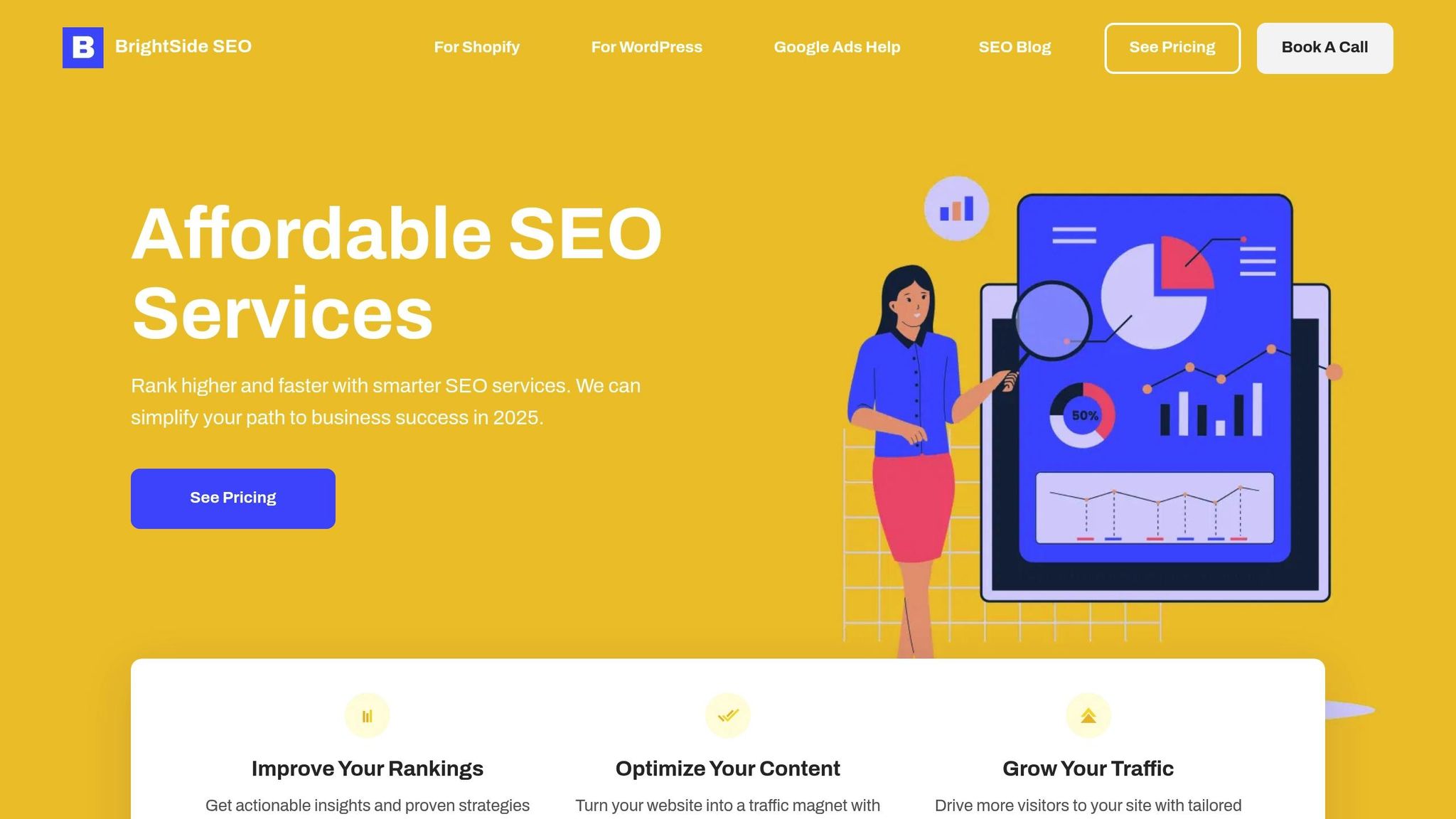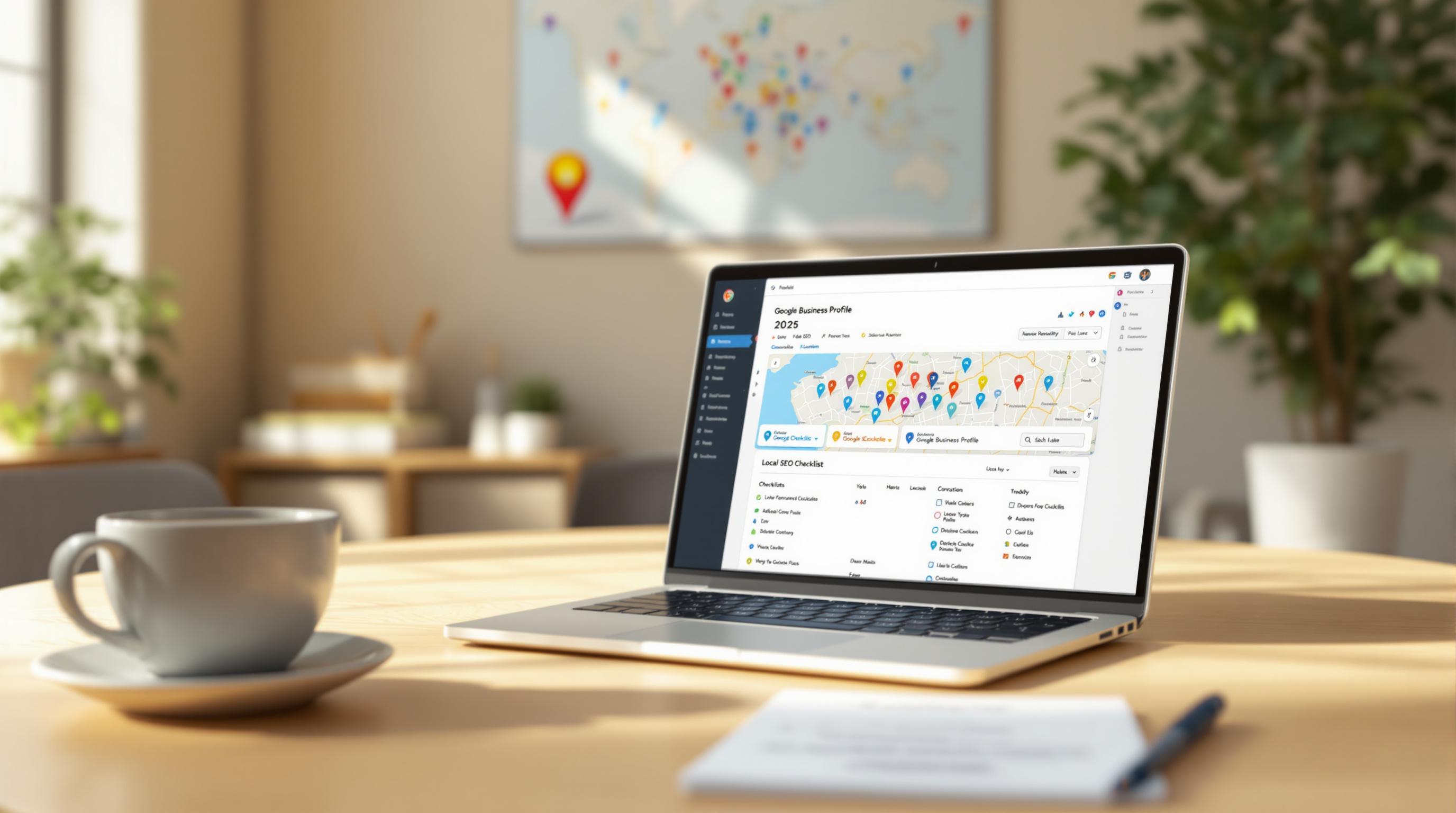SEO is a must for Shopify stores to stand out in the crowded e-commerce market. By optimizing your store, you can attract more traffic, improve user experience, and boost sales. Here’s what you need to focus on:
- Optimize Meta Tags & URLs: Use clear, keyword-rich titles and descriptions for every page.
- Keyword Research: Target specific keywords like product names, categories, and long-tail search terms.
- Content Optimization: Write compelling product descriptions, add blogs, and use internal links.
- Technical SEO: Improve site speed, make your store mobile-friendly, and submit your sitemap to Google.
- Track Performance: Use tools like Google Analytics and Search Console to measure and improve your efforts.
Quick Steps to Get Started:
- Improve your product titles, meta descriptions, and image alt text.
- Research keywords your customers are searching for.
- Speed up your site with image compression and a CDN.
- Submit your sitemap to Google Search Console.
- Regularly update content and monitor SEO performance.
SEO takes time, but these steps can help your Shopify store rank higher and drive more sales.
Shopify SEO Optimization for Beginners - Practical Walkthrough

Using Shopify's Built-In SEO Tools
Shopify comes with built-in tools designed to help you improve your search rankings. Here's how to make the most of them.
Setting Up Meta Tags and URLs
Meta tags are essential for signaling search engines about your page content. Make sure each page has its own unique title and description. For best results, follow these guidelines:
- Homepage titles: Keep them between 50–55 characters.
- Meta descriptions: Stay under 155 characters.
Here’s a helpful structure to follow:
| Page Type | Title Format | Example |
|---|---|---|
| Homepage | Brand - Value Proposition | "Urban Outfitters - Modern Clothing & Lifestyle Essentials" |
| Collection | Category + Brand | "Men's Jackets - Urban Outfitters Collection" |
| Product | Product Name + Key Feature | "Classic Navy Blazer - Free Shipping & Returns" |
Write meta descriptions that encourage action and make users want to click.
"Think of your page title and meta description together just like you would a paid ad. The page title captures the reader's attention and the meta description closes the sale (in this case a click)." - deepfieldinc.com
Don’t stop at meta tags - optimize on-site elements like images for even better results.
Adding Image Alt Text
Alt text improves both your SEO and accessibility. When adding alt text to product images, keep these tips in mind:
- Be descriptive, including details like color, style, and key features.
- Keep it short - stick to under 125 characters.
- Naturally include relevant keywords.
- Avoid keyword stuffing; focus on clear and accurate descriptions.
For example, "Men's Navy Blue Wool Blazer with Brass Buttons" is much more effective than simply saying "blue jacket."
Once your images are optimized, it’s time to ensure your sitemap is properly set up.
Sitemap Setup in Google Search Console
Shopify automatically generates a sitemap for your store at yourdomain.com/sitemap.xml. Use it to help search engines efficiently index your pages. Follow these steps:
- Log in to Google Search Console and verify your domain ownership.
- Go to the Sitemaps section.
- Submit your sitemap URL (yourdomain.com/sitemap.xml).
- Make sure your store isn’t password-protected during the verification process.
- Check your indexing status regularly.
"An XML sitemap aids SEO by acting as a roadmap for search engines, ensuring they can find and index all important pages on a website. It helps in quickly discovering and indexing new or updated content. … For webmasters and SEO managers, it assists in identifying and fixing website errors, improving user experience and search engine rankings." - Arthur Camberlein, technical SEO and data specialist at Shopify
Keyword Research and Content Planning
Keyword research is the backbone of successful Shopify SEO. Here's how to identify and use the right keywords to boost your store's visibility.
Selecting Target Keywords
Getting higher rankings starts with choosing the right keywords. Studies show that the top three search results grab over 58% of all traffic.
When picking keywords, focus on these key categories:
| Keyword Type | Search Intent | Example | Typical Competition |
|---|---|---|---|
| Product-specific | Purchase | "organic dog treats grain free" | Medium |
| Category-based | Browse | "natural pet supplies online" | High |
| Long-tail | Research | "best hypoallergenic dog food for puppies" | Low |
Long-tail keywords make up 96% of searches. They often indicate higher purchase intent and face less competition.
"High performance search engine optimization is built on keyword research, and your keyword research is only as good as your process." - Michael Keenan, Shopify
Writing SEO Product Descriptions
Your product descriptions should combine SEO-friendly elements with content that persuades customers to buy. Strategic keyword use can also increase click-through rates.
Follow these tips for optimizing product pages:
1. Title and URL Structure
Place your main keyword in both the product title and URL. For example, Biossance uses "squalane vitamin C rose oil" effectively in their product titles and URLs.
2. Description Content
Write descriptions that emphasize benefits first, then features. Include your primary keyword naturally 1–2 times, use related terms, and organize the text with bullet points. Be specific about product details to engage shoppers.
3. Image Optimization
Use keywords in image alt tags to improve accessibility and SEO. Keep the descriptions helpful and natural. Together with meta tags, this strengthens your on-site SEO efforts.
Blog Content Strategy
Once your product pages are optimized, leverage blog content to build authority and attract more traffic.
Structure your blog posts around these content types:
| Content Type | Purpose | Example Topic |
|---|---|---|
| How-to Guides | Educational | "How to Choose the Right Size Running Shoes" |
| Product Comparisons | Decision | "Spring vs Memory Foam Mattresses" |
| Buying Guides | Research | "Complete Guide to Gaming Chairs" |
Use internal links to connect blog posts to product pages, enhancing SEO and guiding potential buyers. Regularly update your content to reflect changing search trends. Research shows that 96.54% of keywords in the U.S. have fewer than 50 monthly searches, so targeting multiple related terms can help capture more traffic overall.
sbb-itb-d7fe25c
Technical SEO Improvements
Improving technical aspects strengthens both user experience and search rankings. Research shows that 70% of consumers say slow-loading websites affect their purchasing decisions.
Speed Optimization Tips
Site speed is critical for SEO and revenue. For example, a one-second delay can cost a store with a $60 average order value and 5,000 daily visitors around $9,000 per day.
Here are some ways to improve your Shopify store's speed:
| Speed Factor | Optimization Method | Impact |
|---|---|---|
| Images | Compress and resize | Cuts page weight by 50-75% |
| Scripts | Use async/defer attributes | Speeds up browser parsing |
| Content Delivery | Implement a CDN | Improves load times globally |
| Mobile Performance | Use AMP pages | Boosts mobile speed |
"Quick speed hacks will not build the foundation for long-term performance - only real speed improvements will, and that starts with optimizing your underlying theme architecture."
– Nirav Sheth, CEO and founder of Anatta
Maria Harutyunyan from Loopex Digital shared a success story: "One of our clients had a slow-loading site, so we started by optimizing the images. We made them smaller and compressed them, which made a huge difference in how fast the pages load. In fact, the images now take up 60% less space and load much faster."
Once speed is addressed, focus on optimizing for mobile users.
Mobile Site Optimization
After improving speed, ensure your site delivers a smooth mobile experience. Shopify data reveals that stores using Shop Pay see a 1.91x higher mobile checkout-to-order rate.
- Mobile Performance Testing: Use tools like Google's Mobile-Friendly Test and Lighthouse to check text size, tap targets, and overall usability.
- Mobile Checkout Optimization: Simplify the process by enabling features like Shop Pay.
"Most customers discover products on mobile, and if they have to fill out a form, we've lost them. Enabling Shop Pay in our checkout has really made the most painful point of the customer experience delightful, and since it's tied into the million-merchant ecosystem, even new customers can check out in one click."
– Benjamin Sehl, cofounder of Kotn
Adding Product Schema Markup
In addition to speed and mobile performance, using detailed product data can boost your SEO. Schema markup helps search engines understand your product information better, which can improve click-through rates and visibility.
"Implementing schema markup serves as positive directional information for E-E-A-T, further enhancing your site's credibility in the eyes of both users and search engines."
– Arthur Camberlein, SEO senior specialist at Shopify
To implement schema markup effectively:
- Add structured data in JSON-LD format to your page's
<head>section. - Test your markup using Google's Rich Results Test and request a recrawl in Search Console.
- Track performance using Search Console's rich results reports.
Many Shopify themes include built-in product schema, but you can enhance it further with structured data liquid filters or specialized schema apps.
Link Building Strategy
Getting quality backlinks is key to improving your Shopify store's search rankings. Research shows that relevant, high-quality backlinks signal to search engines that your site has value, which can boost its visibility.
Getting Quality Backlinks
You can earn strong backlinks by creating great content and building solid relationships. Here are some strategies that have worked well for Shopify store owners:
| Link Building Method | How to Do It | Benefits |
|---|---|---|
| Manufacturer Partnerships | Ask vendors to list your store | Industry-specific backlinks |
| Guest Content Creation | Write detailed posts for blogs | Targeted referral traffic |
| HARO Responses | Answer journalist questions | Mentions on trusted media sites |
| Influencer Interviews | Publish expert roundups | Social shares and backlinks |
One standout tactic is the "Skyscraper" technique. Here's how it works: find popular content from competitors, create an improved version, and then reach out to the websites linking to the original. This is particularly effective for product guides and industry-specific resources.
While external links are important, don't underestimate the power of a strong internal linking strategy.
Internal Link Structure
Once you’ve built external links, focus on improving your internal linking structure. Internal links help search engines understand your site’s layout and make it easier for visitors to navigate. Plus, they allow you to distribute page authority across your site.
Here’s how to create a solid internal linking strategy:
-
Set Up Clear Navigation Paths
Make sure visitors can easily move from the homepage to category pages and then to specific products. Add links within product descriptions to related items or complementary accessories. -
Connect Content Strategically
Link blog posts to relevant product pages using descriptive anchor text. For instance, if you’re writing about summer fashion trends, link directly to products that fit those trends. -
Use Collection Pages
Group related products on collection pages. This not only helps users find items faster but also shows search engines how your products are connected.
SEO Tools and Analytics
Once your technical SEO and link-building efforts are in place, the right tools and analytics can take your strategy further. These resources help you track performance and make informed adjustments. Below, explore recommended Shopify SEO apps, a quick guide to Google Search Console, and how BrightSide SEO Services can enhance your store's visibility.
Top Shopify SEO Apps
Using the right apps can improve your store's SEO performance. Here are some popular options based on features and user feedback:
| App Name | Key Features | Monthly Cost |
|---|---|---|
| BOOSTER SEO | Image optimization, meta tags, automated fixes | $39 - $69 |
| TinyIMG | Image compression, ALT tag automation | $1.99+ |
| Smart SEO | Multi-language support, structured data | $9.99 |
| JSON-LD | Product schema markup | $299 one-time fee |
Choose apps that align with your specific goals. For instance, if your site is slow, tools like TinyIMG can compress images and improve loading times without sacrificing quality.
Google Search Console Setup
Follow these steps to set up Google Search Console for your Shopify store:
-
Add Your Store
Enter your Shopify store's URL and verify ownership using Google Analytics. -
Submit Your Sitemap
Provide your sitemap (yourdomain.com/sitemap.xml) to help Google understand your store's structure. -
Monitor Key Metrics
Keep an eye on the following data points to track performance:- Clicks, impressions, and CTR (search performance)
- Mobile usability issues
- Core Web Vitals
- Index coverage
- Rich results status
BrightSide SEO Services

BrightSide SEO offers Shopify-focused optimization services designed to boost your store's performance. Their Starter Plan includes tracking for 10 keywords, schema markup, and monthly performance reports. The Growth Plan covers up to 20 keywords and adds content creation support.
Core services include:
- Keyword research and tracking
- Technical SEO improvements
- Schema markup setup
- Content strategy planning
- Performance monitoring
Using these tools and services, you can identify areas for improvement and keep your store ranking well in search results. Analytics help you refine your approach based on real-world data.
Conclusion: Your SEO Action Plan
Key Steps to Focus On
Here’s a quick recap of the essential strategies to boost your SEO efforts. Prioritize these areas:
-
Technical Setup:
- Get a custom domain.
- Submit your sitemap using Google Search Console.
- Make sure your site is mobile-friendly.
- Fix any broken links.
-
On-Page SEO:
- Craft title tags (up to 60 characters) and meta descriptions (up to 160 characters).
- Write keyword-focused, unique product descriptions.
- Add alt text to all images.
- Use product schema markup to enhance search visibility.
-
Content Approach:
- Use tools like Google Trends for keyword research.
- Organize your site with a clear hierarchy.
- Publish blog posts that address buyer needs.
- Strengthen internal linking between pages.
Routine SEO Maintenance
Once your store is optimized, maintaining it is just as important. Stick to a regular schedule to keep your SEO on track:
-
Weekly Tasks:
- Monitor keyword rankings.
- Fix any broken links.
- Check for crawl errors.
-
Monthly Tasks:
- Review performance metrics.
- Refresh and improve product descriptions.
- Optimize pages that aren’t performing well.
- Add new blog content.
-
Quarterly Tasks:
- Conduct updated keyword research.
- Review and adjust schema markup.
- Evaluate your site’s structure.
- Test your site’s mobile performance.
BrightSide SEO Services
Need help managing your SEO? BrightSide SEO offers tailored Shopify optimization plans:
| Plan | Cost Per Month | Features Included |
|---|---|---|
| Starter Plan | $599 | 10 keywords, 5 blog posts, schema setup |
| Growth Plan | $899 | 20 keywords, 10 blog posts, reporting |
| Premium Plan | $1399 | 30 keywords, 15 blog posts, priority support |
SEO requires ongoing effort and attention. By following these steps or teaming up with BrightSide SEO, you can build and maintain strong search visibility for your store.


